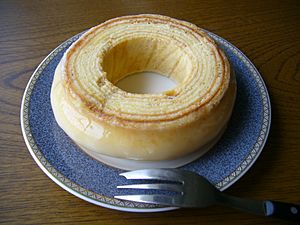Baumkuchen facts for kids
Baumkuchen (say it like bowm-koo-ken) is a special type of cake from German cuisine. It's also a very popular dessert in Japan. The cake gets its name, which means "tree cake" or "log cake" in German, from its unique look. When you slice it, you see many rings, just like the rings inside a tree trunk.
What is Baumkuchen?
Traditionally, Baumkuchen is made on a special rotating rod called a spit. Bakers brush thin layers of batter onto the spit. They then turn the spit over a heat source. Each layer browns before a new layer of batter is added.
When the cake is finished and sliced, each layer has a golden line. This makes it look exactly like the growth rings of a tree. A typical Baumkuchen has about 15 to 20 layers. Some skilled bakers can make cakes with 25 layers or more. These can weigh over 45 kilograms (100 pounds)! A finished Baumkuchen cooked on a spit can even be 90 to 120 centimeters (3 to 4 feet) tall.
The main ingredients for Baumkuchen are butter, eggs, sugar, vanilla, salt, and flour. Baking powder is usually not used. The recipe often uses equal amounts of flour and butter, and twice as much egg. For example, 100 grams of flour would use 100 grams of butter and 200 grams of eggs.
You can change the recipe by adding things like ground nuts, honey, or marzipan. Some recipes also include rum or brandy. Baumkuchen is often covered with a sugar or chocolate glaze. Sometimes, a fully baked and cooled Baumkuchen is first coated with jam. Then, it is covered with chocolate.
Baumkuchenspitzen means "Tree Cake Points" in German. These are small versions of Baumkuchen. They are made from pieces of cake that fall off while the main cake is being made. These small pieces are usually covered in chocolate and sold separately.
There is also a simpler version of the cake called a "Schichttorte." This cake is baked in horizontal layers, not on a spit. So, it does not have circular rings. Instead, it has flat, horizontal layers. This version looks more like a regular cake. You can bake it in a normal oven with a broiler. The traditional spit version needs special equipment. However, the Schichttorte does not look as much like tree rings when sliced.
History of Baumkuchen
No one knows for sure who made the first Baumkuchen or where it was baked. One idea is that it was invented in the German town of Salzwedel. The town itself often promotes this idea. Another theory suggests it started as a wedding cake in Hungary.
A cookbook called Ein new Kochbuch (meaning "A New Cookbook") has a recipe for Baumkuchen. This book was written by Marx Rumpolt in 1581. He was a chef who had worked in Hungary and Bohemia. This shows that Baumkuchen has been around for a very long time.
Baumkuchen in Japan
Baumkuchen is one of the most loved pastries in Japan. There, it is called baumukūhen. It is a popular gift for wedding guests in Japan. This is because its ring shape reminds people of wedding rings.
A German man named Karl Juchheim first brought Baumkuchen to Japan. He was in China during World War I. After the war, the Japanese Army moved him and his wife to Japan. In 1919, Juchheim started making and selling Baumkuchen at a German exhibition in Hiroshima.
He became very successful. He moved to Yokohama and opened a bakery. But his bakery was destroyed in the Great Kanto Earthquake of 1923. So, he moved his business to Kobe. He stayed there until the end of World War II. Years later, his wife helped a Japanese company open bakeries using the Juchheim name. This helped Baumkuchen become even more popular in Japan. These bakeries are still open today.
fr:Gâteau à la broche
See also
 In Spanish: Baumkuchen para niños
In Spanish: Baumkuchen para niños




